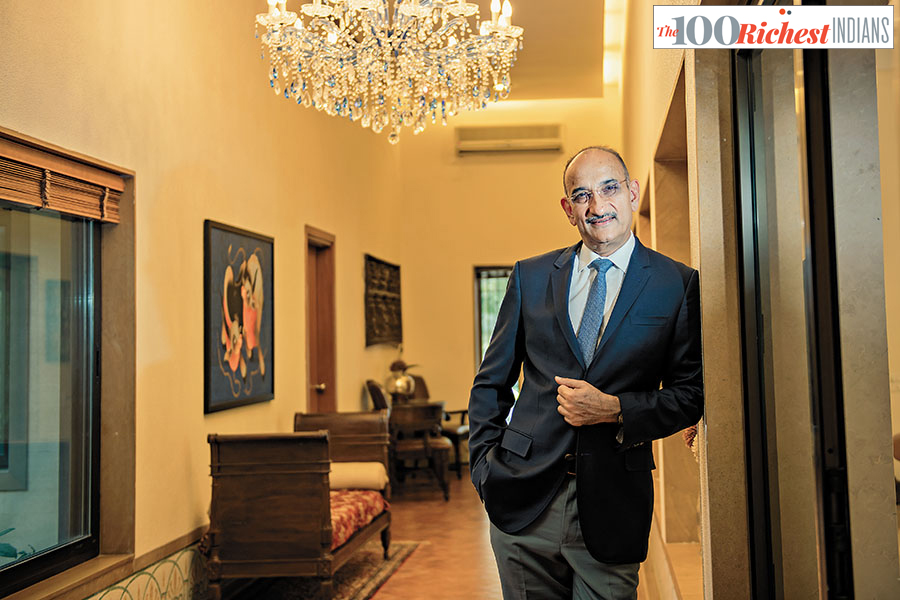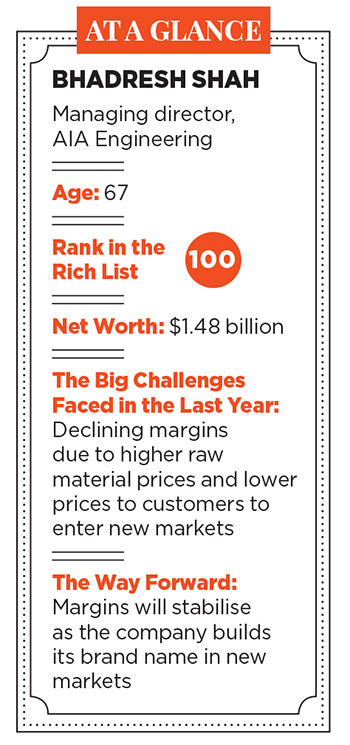
Bhadresh Shah: Colours of chrome
The founder of AIA Engineering returns to the Rich List after seven years by adding more heft to his metallurgical export power house
 Bhadresh Shah has no plans to diversify AIA’s business though it is generating more cash than he can invest
Bhadresh Shah has no plans to diversify AIA’s business though it is generating more cash than he can investImage: Mayur Bhatt for Forbes India
Bhadresh Shah remembers his early brush with entrepreneurship with a hint of embarrassment. Soon after he graduated from IIT-Kanpur in 1975, he found himself back in his hometown Ahmedabad and, as he remembers, “The problem in Gujarat is that everyone wants to be an entrepreneur.” So with ₹1 lakh in capital, the metallurgical engineer set up a small foundry that made pressure dye castings and succeeded in losing all his money in the first year.

Clearly Shah sees a long runway ahead. It is an assessment the analyst community agrees with. “There is a huge opportunity in the wear parts business in the mining space with global demand at 3 million tonnes and penetration by ferrochrome alloys at less than 20 percent,” says Shradha Sheth, research analyst, institutional equities, Edelweiss. After its recent expansion, AIA’s capacity stands at 440,000 tonnes. At 32 times earnings (₹14,200 crore market cap) the stock is pricing in rapid future growth even though the last five years have been subdued with profits rising by 6.3 percent a year to ₹443 crore.
What makes the success of Shah, who is back on the 2018 Rich List at rank 100 after a gap of seven years, even more noteworthy is that he has built his niche in a B2B business where customers usually have the upper hand. The technical name for what AIA supplies is ‘high chrome mill internals’. These are the metal alloys that are coated on everything from grinders to crushers and allow mills to function more effectively. The company boasts of 100 different alloys. His main competition is from a global company, Magotteaux, which was once his partner. For many, AIA’s slow and measured expansion is a textbook study on how Indian companies should expand their business overseas. But before we get there let’s take a look at how AIA built its capabilities.
Soon after running through his initial capital in 1975, Shah said he had no choice but to keep his plant operational. His first task after losing his initial capital was getting himself on the list of suppliers to the Ahmedabad Electricity Company. Once in, he used his time to suggest improvements and went beyond the role of an ordinary supplier. His parts were used in pulverisers and boilers and that was where metallurgy played a role. Shah’s suggested changes resulted in the parts performing better and this gave Shah the confidence to spend on research. As his business grew, Shah started thinking about other areas where he could expand and set up Ahmedabad Induction Alloys or AIA.
What set Shah apart, even in those early days, was his ability to be on the constant lookout for new business lines. At the same time he was clear that the business had to be built on a strong technological backbone; over the next two decades Shah tied up with Slegten, a Belgium headquartered maker of mill linings and mill internals, and formed a joint venture (JV) with Magotteaux. It was here that AIA started making chromium alloys that are then used to coat linings for grinding equipment in say, a cement plant or a mine. The alloys are melted and then put into moulds, heat-treated and shipped to factories in India and the world over.
As his business grew (and the tie-up with Magotteaux matured), Shah shifted base to Belgium in 1996 to work as an employee. But it was his decision a year and a half later to move back that would set AIA on the path to success. As an entrepreneur, he wanted the Indian JV to succeed. “I thought they were not paying enough attention to the Indian joint venture of which I was a 49 percent owner,” he says. He knew if he stayed on in Belgium, the Indian plants would never become exporters as they would serve only the Indian market or at best the subcontinent. They would probably not push themselves to adopt the best manufacturing practices and would never become world beaters in what they produced. The entrepreneur in Shah decided to take over. He knew that the Indian market was finite and for him to succeed in the long run he would have to look for markets outside India.
 AIA’s capacity stands at 440,000 tonnes. It exports three quarters of what it produces
AIA’s capacity stands at 440,000 tonnes. It exports three quarters of what it producesDuring the course of the conversation, Shah’s lament is similar to what other Indian manufacturing entrepreneurs say. As he set about courting global customers he found it difficult to break in. “For global companies, references from Indian customers are usually not acceptable,” says Shah. In the early 2000s, help came in the form of FL Smidth, an original equipment manufacturer for cement plants. They would instal plants with AIA’s equipment and after a few years of wear and tear customers would call AIA to either replace the equipment or for maintenance. That was when AIA first got to showcase its engineering capabilities. Once global companies operating in India started recommending AIA, the company managed to get its foot into their plants overseas.
In servicing industrial customers AIA made sure it got three things right. First, it made sure that the maintenance down time was kept to a bare minimum. Second, customers in the industrial space have zero tolerance for failure and it made sure its products had a zero fail rate. Third, the industries AIA serves are power-intensive. AIA made sure that the companies are able to manage a substantial amount of power savings. “It would take us many years to break into a customer but once we were in we made sure they were wedded to us,” says Shah. As customers are often far away, the three assurances that AIA gives are on quality, wear resistance and timely delivery.
In addition to building an export powerhouse what makes Shah’s achievement more commendable is that he has done this with an efficient use of capital. The company’s return on equity has averaged 16 percent over the last five years. This number is probably depressed as the company has adopted ‘penetrative pricing’ to enter new markets and should get normalised to a higher level once it achieves scale in these new markets. The company says a declining rupee is margin neutral as raw material prices are quoted in US dollars and automatically adjust upwards with a declining rupee. This negates the benefit of higher revenues from customers due to a weaker rupee. It has no long term debt but has recently added ₹122 crore of working capital.
For now the company has planned its next round of expansion to take it to 440,000 tonnes past its erstwhile partner Magotteaux. Demand is likely to come primarily from mining and to a lesser extent cement. Sheth of Edelweiss sees the company clocking 25 percent a year growth in the mining space. The third business line of power plants is unlikely to see an uptick as the world moves away from coal-based plants to renewable sources of energy. One geography where the company lacks a presence is China. While Shah agrees it is a huge market, it is dominated by local companies and he is unable to do business unless he partners with a local entity. For now he has no plans to enter China. One red flag on the horizon is the imposition of tariffs on Chinese exports that may prompt Chinese manufacturers to dump in other markets. AIA has adopted a wait-and-watch attitude.
As AIA enters its fourth decade —it was founded in 1979—Shah is certain that he plans no business diversifications even though the business is generating more cash than he can invest. The company will in the next few years have to take a call on how best to invest the cash or pay it out to shareholders. For now the view is there should be enough investible opportunities as chrome takes away market share from other grinding media. But perhaps Shah’s enduring legacy is that he has ensured that the company works as efficiently without him as it does with him. He comes to office only when he has a meeting and has delegated all responsibility to his team. He has also stopped visiting customers. His office has no computer and a conference table doubles as his desk. “Work permitting, I encourage everyone in office to leave by 5 pm,” he says with a smile.
(This story appears in the 28 December, 2018 issue of Forbes India. To visit our Archives, click here.)
Post Your Comment















